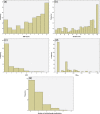Associations between different measures of anticholinergic drug exposure and Barthel Index in older hospitalized patients
- PMID: 25114784
- PMCID: PMC4125311
- DOI: 10.1177/2042098613500689
Associations between different measures of anticholinergic drug exposure and Barthel Index in older hospitalized patients
Abstract
Objective: To compare associations between four measures of anticholinergic exposure (anticholinergic risk scale, ARS; anticholinergic drug burden, DBAC; number and use versus no use of anticholinergic drugs), Barthel Index (BI, physical function) and Abbreviated Mental Test (AMT, cognitive function) on admission in older hospitalized patients.
Methods: Prospective observational study of a consecutive series of 271 older patients (age 83 ± 7 years) from community-dwelling and institutionalized settings, admitted to an acute geriatric admission unit between 28 September 2011 and 18 December 2011. The main outcome measures were BI quartiles (primary outcome) and AMT (secondary outcome) on admission.
Results: Anticholinergic prevalence was 47%. Multinomial logistic regression showed higher DBAC was associated with a greater risk of being in the lower BI quartiles versus highest BI quartile (Q4). This risk was significant for Q3 (p = 0.04) and Q2 (p = 0.02) but not for Q1 (p = 0.06). A greater number of anticholinergic drugs was associated with a higher risk of being in Q2 (p = 0.02). This risk was not significant for either Q3 (p = 0.10) or Q1 (p = 0.06). No significant associations were observed either with use of anticholinergic medication or with ARS and BI quartiles. AMT did not show independent associations with any of the four measures of anticholinergic exposure.
Conclusion: In older hospitalized patients, DBAC and some crude measures of anticholinergic exposure, but not ARS, showed independent associations with lower BI, but not AMT. These results highlight differences between various measures of anticholinergic drug exposure when studying their associations with functional status.
Keywords: Aged; Anticholinergic Risk Scale; Barthel Index; Drug Burden Index; cholinergic antagonists; drug toxicity; frail elderly; muscarinic antagonists.
Conflict of interest statement
Figures
Similar articles
-
Anticholinergic drugs and functional outcomes in older patients undergoing orthopaedic rehabilitation.Am J Geriatr Pharmacother. 2012 Aug;10(4):251-7. doi: 10.1016/j.amjopharm.2012.06.003. Epub 2012 Jul 13. Am J Geriatr Pharmacother. 2012. PMID: 22795433
-
Associations between the anticholinergic risk scale score and physical function: potential implications for adverse outcomes in older hospitalized patients.J Am Med Dir Assoc. 2011 Oct;12(8):565-572. doi: 10.1016/j.jamda.2011.03.006. Epub 2011 Apr 21. J Am Med Dir Assoc. 2011. PMID: 21514242
-
Association of anticholinergic burden with cognitive and functional status in a cohort of hospitalized elderly: comparison of the anticholinergic cognitive burden scale and anticholinergic risk scale: results from the REPOSI study.Drugs Aging. 2013 Feb;30(2):103-12. doi: 10.1007/s40266-012-0044-x. Drugs Aging. 2013. PMID: 23239364
-
Anticholinergic Burden and Fractures: A Systematic Review with Methodological Appraisal.Drugs Aging. 2020 Dec;37(12):885-897. doi: 10.1007/s40266-020-00806-6. Epub 2020 Oct 23. Drugs Aging. 2020. PMID: 33094444 Free PMC article.
-
Drugs with anticholinergic effects and cognitive impairment, falls and all-cause mortality in older adults: A systematic review and meta-analysis.Br J Clin Pharmacol. 2015 Aug;80(2):209-20. doi: 10.1111/bcp.12617. Epub 2015 May 20. Br J Clin Pharmacol. 2015. PMID: 25735839 Free PMC article.
Cited by
-
Using electronic admission data to monitor temporal trends in local medication use: Experience from an Australian tertiary teaching hospital.Front Pharmacol. 2022 Oct 14;13:888677. doi: 10.3389/fphar.2022.888677. eCollection 2022. Front Pharmacol. 2022. PMID: 36313311 Free PMC article.
-
Anticholinergic burden (prognostic factor) for prediction of dementia or cognitive decline in older adults with no known cognitive syndrome.Cochrane Database Syst Rev. 2021 May 5;5(5):CD013540. doi: 10.1002/14651858.CD013540.pub2. Cochrane Database Syst Rev. 2021. PMID: 34097766 Free PMC article.
-
The Prognostic Value of Anticholinergic Burden Measures in Relation to Mortality in Older Individuals: A Systematic Review and Meta-Analysis.Front Pharmacol. 2020 Apr 29;11:570. doi: 10.3389/fphar.2020.00570. eCollection 2020. Front Pharmacol. 2020. PMID: 32411001 Free PMC article.
-
An Evaluation of Longitudinal Measures of Anticholinergic Exposure for Application in Retrospective Administrative Data Analyses.Adv Ther. 2019 Sep;36(9):2247-2259. doi: 10.1007/s12325-019-01035-z. Epub 2019 Aug 5. Adv Ther. 2019. PMID: 31385284 Free PMC article.
-
Association Between Objectively Measured Physical Activity and Opioid, Hypnotic, or Anticholinergic Medication Use in Older People: Data from the Physical Activity Cohort Scotland Study.Drugs Aging. 2018 Sep;35(9):835-842. doi: 10.1007/s40266-018-0578-7. Drugs Aging. 2018. PMID: 30105644
References
-
- Bostock C., Soiza R., Mangoni A. (2010) Association between prescribing of antimuscarinic drugs and antimuscarinic adverse effects in older people. Expert Rev Clin Pharmacol 3: 441–452 - PubMed
-
- British Medical Association and Royal Pharmaceutical Society of Great Britain (2011) British National Formulary, 62nd edition. London: RPS Publishing
-
- Cao Y., Mager D., Simonsick E., Hilmer S., Ling S., Windham B., et al. . (2008) Physical and cognitive performances and burden of anticholinergics, sedatives, and ACE inhibitors in older women. Clin Pharmacol Ther 83: 422–429 - PubMed
-
- Casarosa P., Keichle T., Sieger P., Pieper M., Ganter F. (2010) The constitutive activity of the human muscarinic M3 receptor unmasks differences in the pharmacology of anticholinergics. J Pharmacol Exp Ther 333: 201–209 - PubMed
-
- de Groot V., Beckerman H., Lankhorst G., Bouter L. (2003) How to measure comorbidity: a critical review of available methods. J Clin Epidemiol 56: 221–229 - PubMed
LinkOut - more resources
Full Text Sources
Other Literature Sources


